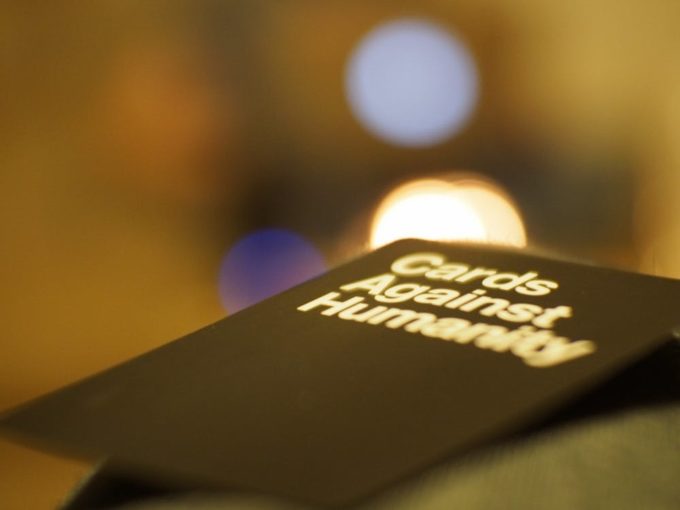Cards Against Humanity, LLC v. Vampire Squid Cards, LLC, Opposition No. 91225576, hosted by United States Patent and Trademark Office
The Trademark Trial and Appeal Board (“Board”) sustained an opposition by Cards Against Humanity (“CAH”) to a trademark application by Vampire Squid Cards (“VSC”) for their product, Crabs Adjust Humidity (“CrAH”). The opposition proceeding, in which the opposing party (CAH) files a formal opposition based on their own marks to the applicant (CrAH), is used to determine whether the applicant has the right to register their marks. Earlier in the proceeding, the Board granted partial summary judgment to CAH, holding that it had standing and priority of use for game cards.
Administrative Trademark Judge Thomas Wellington wrote for the three-judge panel, holding that the Board would not grant the trademark because it would likely confuse the public. The Board found by a preponderance of the evidence that granting the CrAH trademark would cause consumers “to believe mistakenly that [CrAH] originate[d] with, or [is] licensed, sponsored, or authorized by” CAH.
Cards Against Humanity, first marketed in 2010 as “a party game for horrible people,” involves one player asking a question from a black card. The other players select the most entertaining answer from their set of white cards, and the question-asker decides whose response is the most humorous. The game has been listed as a “best seller” on Amazon since 2010, was the subject of a New York Times article documenting its fame, and is popular among such celebrities as Kim Kardashian West.
VSC devised CrAH for use as an “expansion pack” in conjunction with CAH that would “rhym[e] with it, but in an absurdist and surreal way.” After some email back-and-forth with CAH regarding the possibility of a licensing agreement and specifics of the mark, VSC seems to have believed it had permission to sell its cards. Nonetheless, VSC sought CAH’s further approval when it tried to sell its cards at Target prior to filing the trademark application.
In its holding, the Board determined whether there would be a likelihood of consumer confusion under the test identified in du Pont. In re E. I. du Pont de Nemours & Co., 476 F.2d 1357 (C.C.P.A. 1973). The Board noted that the most important of the thirteen enumerated factors in du Pont are consideration of the similarities between the goods and consideration of the similarities between the marks. As admitted by both parties, the game cards are identical, so the Board presumed their channels of trade and purchasers are the same. Additionally, considering their low cost and “somewhat whimsical” subject matter used for “casual amusement,” the Board found both sets of cards the subject of “impulse purchasing.” Accordingly, the related du Pont factors weigh heavily toward a likelihood of confusion.
The Board found the two marks “quite similar” in appearance, partly because of their three words that “employ the same syntax,” described by VSC as an “homage” to CAH. Both marks are “somewhat absurd” because a literal reading of their words “creates nonsensical expressions.”
Although the Board noted that the crab adjusting the dial on the CrAH mark was not present in CAH’s mark, it nonetheless found the two marks similar enough to generate a likelihood of confusion.
Several other factors also favor CAH, including its aforementioned high degree of fame, which increases the risk of confusion. Additionally, instances of actual confusion favor the opposition. Consumers have indicated their confusion between CAH and CrAH online, and several Amazon reviews suggest accidental purchases of CrAH. Of the discussed factors, only applicant’s bad faith did not weigh in CAH’s favor, since VSC’s attempt to copy does not indicate their intent to confuse.
VSC presented several affirmative defenses that the Board rejected. VSC claimed that CAH was estopped by acquiescence or estopped by express consent because it consented to VSC’s using its marks by email. Estoppel by acquiescence would require CAH’s active representation that it would not assert a claim against VSC; in this case, there was no showing that CAH had a non-excusable delay in asserting its rights. In rejecting estoppel by express consent, the Board noted that consent to use the marks differed from consent to register the marks. Furthermore, VSC presented an affirmative defense of “unclean hands,” claiming that CAH was engaging in unlawful restraint of trade. The Board concluded that such a defense was unavailable since it lacked jurisdiction to make such a determination. Finally, VSC defended itself on the grounds that CrAH is a “parody” of CAH. The Board held that, because CAH and CrAH are otherwise similar goods, parody is not a defense.
John L. Welch of Wolf Greenfield on The TTABlog provides an overview of the case. Karen Artz Ash and Bret J. Danow of Katten Muchin Rosenman on The National Law Review provide detailed commentary on the estoppel by acquiescence defense raised by VSC.
